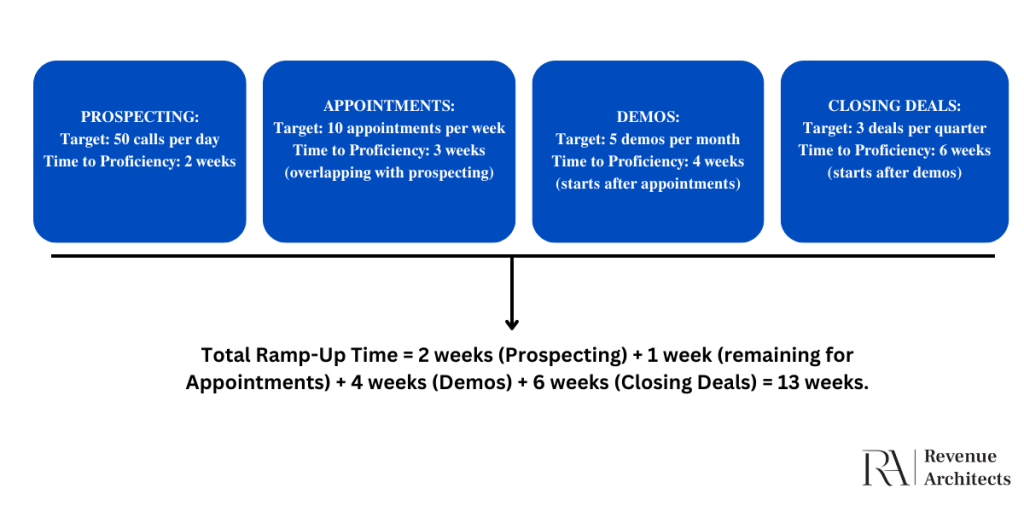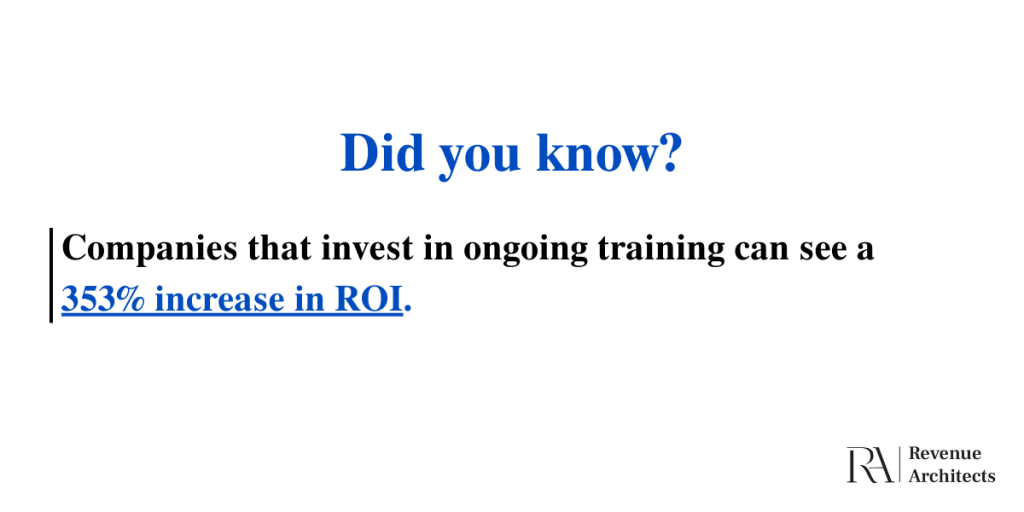The efficiency and speed at which new Account Executives (AEs) ramp up to full productivity are something that is often overlooked. Yet, optimizing this ramp-up process not only boosts revenue but also improves resource allocation and overall team morale. This comprehensive guide explores various strategies, methodologies, and best practices to accelerate the ramp-up time for AEs based on insights from industry experts.
The Importance of Ramping-Up for Account Executives
Definition and Impact
Ramping-up time for Account Executives refers to the period it takes for a new AE to become fully productive, which includes understanding the product, mastering the sales cycle, and achieving sales quotas. It means how much time is needed for a successful onboarding in plain language. On average, for tech companies, this period ranges from three to nine months, influenced by factors such as industry specifics, product complexity, and the AE’s prior experience. Optimizing ramp-up time is essential because prolonged ramp-up can lead to missed sales opportunities and higher costs for onboarding. The longer your Account Executive takes to ramp up to full potential, the longer your company endures higher costs without corresponding revenue generation.
Key Components of Effective Ramping-Up
Comprehensive Training and Onboarding
Training programs are the cornerstone of a successful ramp-up. Effective training should be comprehensive, covering product knowledge, sales techniques, prospecting, CRM systems, pipeline management and industry-specific insights. A blend of classroom training, e-learning modules, and hands-on practice is recommended.
Understanding the Sales Cycle
AEs must be adept at navigating the sales cycle, from cold calling to closing deals. This requires both theoretical knowledge and practical experience. Role-playing sessions and mock sales calls can help AEs refine their skills before engaging with actual clients, ensuring they are well-prepared for real-world interactions. Having a good understanding of issues that clients face is another very valuable lesson, so working with the client success department from the outset is a great practice.
Quota Achievement and Performance Metrics
Reaching and surpassing sales quotas is a primary indicator of an AE’s ramp-up progress. Implementing a tiered quota system allows new AEs to build confidence and competence gradually. Regular monitoring of performance metrics helps identify areas needing improvement and adjust training programs accordingly.
Calculating Ramp-Up Time
Different methodologies exist for calculating ramp-up time, but it’s crucial to choose the one that best suits your industry. Here are the four main approaches, which you can explore further in our previous article on calculating ramp-up time.
- Average Sales Cycle Plus Buffer: This method involves adding a buffer period (e.g., 90 days) to the average sales cycle. While straightforward, this approach can be imprecise if not supported by sufficient historical data.
- Sales Cycle Plus Training and Experience: This method adds the time taken for initial training and factors in the AE’s previous experience. However, accurately quantifying the impact of prior experience can be challenging.
- Time to Reach 100% Quota: This widely used method calculates ramp-up time based on the average period taken for AEs to achieve 100% of their quota. It inherently factors in variations in experience and training effectiveness, offering a more reliable metric.
4. Calculating Sales Ramp-up by Activity Metrics: This method analyzes prospects found, calls made, and deals closed. Achieving the required metrics marks the end of the ramp-up cycle.

Industry Benchmarks
Benchmarks vary, with some reports suggesting an average ramp-up time of 3.2 months for tech companies, while other sectors may see averages extending up to nine months. These benchmarks help set realistic expectations and targets for ramp-up programs but are not there to be followed blindly. Companies should assess their own needs and capabilities to determine which benchmarks are most relevant. They should then adjust their ramp-up plans accordingly to ensure successful and timely completion.
Strategies to Reduce Ramp-Up Time
Personalized Training Programs
Tailoring training to individual needs can accelerate learning and productivity. By assessing each Account Executive’s background and designing customized training plans, you can address specific knowledge gaps and leverage their strengths. Some sales reps may join the company with varying levels of experience, while others, despite being younger, may ramp up faster due to their eagerness to learn. The personalized approach from Revenue Architects ensures that each individual is supported effectively while learning about handling objections, prospecting, and securing favorable outcomes.
Mentorship and Peer Learning
Establishing mentorship programs where new AEs are paired with experienced salespeople can provide guidance and support. Additionally, fostering a culture of peer learning encourages knowledge sharing and collaboration, further enhancing the ramp-up process.

Leveraging Technology
Utilizing CRM systems, sales enablement platforms, and analytics tools can streamline the ramp-up process. These technologies provide real-time data and insights, allowing AEs to make informed decisions and track their progress effectively.
Case Studies and Best Practices for ramping up AEs
Successful Implementations
For example, a tech company that implemented a gamified training program saw a 30% reduction in ramp-up time. Another firm used data analytics to pinpoint and address onboarding challenges, cutting the ramp-up period by 25%. These cases underscore the importance of innovative and data-driven approaches to training and onboarding.
Lessons Learned
Continuous improvement is key. Regularly reviewing and refining ramp-up processes based on feedback and performance data can lead to significant gains. It’s also essential to consider the unique aspects of different sales roles and tailor ramp-up strategies accordingly.
3 Best Practices in Sales Onboarding

Ongoing Training
Sales onboarding should not be a one-time event but an ongoing process. Continuous training programs that provide updates on new products, market trends, and advanced sales techniques help maintain high levels of productivity. According to Quwilr, companies that invest in ongoing training can see a 353% increase in ROI.
Tailored Onboarding Programs
A one-size-fits-all approach to onboarding is outdated. Tailoring onboarding programs to different roles and experience levels can significantly enhance their effectiveness. Experienced hires may require less foundational training but more advanced coaching, while entry-level AEs might need comprehensive training on basics and sales fundamentals.
Using Data to Drive Onboarding
Tracking key metrics related to onboarding can provide valuable insights into the effectiveness of your training programs. Metrics such as time to first deal, time to quota attainment, and retention rates can highlight areas for improvement and help refine your onboarding processes.
Integrating a Structured Onboarding Plan for Faster AE Ramp-Up
One of the most effective strategies to accelerate the ramp-up time for Account Executives (AEs) is through a well-structured onboarding plan. A comprehensive onboarding plan ensures that new hires are not only familiarized with company processes and tools but are also equipped with the knowledge and skills necessary to perform at their best from the outset. Below, we’ll explore how incorporating a detailed 30-60-90 day plan into your AE onboarding process can drastically reduce ramp-up times and enhance overall performance.
The 30-60-90 Day Onboarding Plan: A Blueprint for Success
A 30-60-90 day plan breaks down the onboarding process into three distinct phases, each with specific milestones and objectives. This structured approach ensures that new AEs progress at a steady pace, building their knowledge base and skill set progressively, which is critical for long-term success in their role.
Day 1-30: Learning and Development In the first 30 days, the focus is on immersing the new AE in the company’s culture, processes, and products. This phase includes:
- Team Integration: Meeting the team and getting an overview of key processes across departments like marketing, sales, customer success, and product development.
- Product and Tools Training: Engaging in intensive product training sessions, familiarizing with sales tools, CRM systems, and other relevant materials. This phase might include resources like CRM training videos, sales playbooks, case studies, and live platform walkthroughs.
- Initial Engagements: The new AE will start observing and participating in customer calls to understand client interactions and the sales cycle. By the end of this phase, the AE should be able to present their learnings to senior leadership, demonstrating their understanding and readiness to move forward.
Day 31-60: Performance and Skill Enhancement During the next 30 days, the focus shifts to applying the knowledge gained in real-world scenarios:
- Shadowing and Mentorship: The AE will shadow experienced salespeople to gain deeper insights into customer interactions and processes, enhancing their practical understanding.
- Initial Prospecting and CRM Mastery: The AE begins initial prospecting activities and continues mastering the CRM and other sales tools, transitioning outbound activities as they grow more confident.
- Meeting Milestones: By Day 60, the AE is expected to have conducted several customer meetings, with the goal of closing their first account by Day 45.
Day 61-90: Autonomy and Achievement The final phase is about taking full ownership and driving results:
- Pipeline Ownership: The AE begins taking full responsibility for their sales pipeline, managing and nurturing leads independently.
- Quota Attainment: The focus here is on meeting and exceeding KPIs, setting up demo meetings, and closing additional deals. By Day 90, the AE should have a solid lead-to-deal conversion rate and be fully ramped up, ready to consistently contribute to the company’s revenue goals.
Benefits of a Structured Onboarding Plan
Implementing a 30-60-90 day plan as part of your AE onboarding process offers several advantages:
- Accelerated Learning Curve: By breaking down the onboarding process into manageable phases, new AEs can quickly build confidence and competence, reducing the overall ramp-up time.
- Clear Expectations and Accountability: A structured plan sets clear expectations for new hires, helping them stay focused and motivated to meet their goals.
- Continuous Feedback and Improvement: Regular check-ins and performance evaluations during each phase allow for continuous feedback, enabling adjustments and improvements to be made as needed.
Need more guidance about ramping up Account Executives?
Optimizing the ramping-up time for Account Executives is a complex but critical endeavor that requires a strategic approach. When you understand the key components, employ effective methodologies, and implement best practices, your company can significantly reduce ramp-up time and enhance sales performance.
Continuous evaluation and adaptation of ramp-up processes are essential to maintain a competitive edge. If you need guidance in training your AEs, contact us anytime for personalized support and expert advice tailored to your team.

